МОДЕЛИРОВАНИЕ УСТАНОВОК ОБРАТНОГО ОСМОСА ДЛЯ СТАНЦИЙ ОЧИСТКИ СТОЧНЫХ ВОД
Слесаренко В.В.1
1Доктор технических наук, профессор, Дальневосточный федеральный университет; Федеральное государственное бюджетное учреждение науки Институт химии Дальневосточного отделения Российской Академии наук.
МОДЕЛИРОВАНИЕ УСТАНОВОК ОБРАТНОГО ОСМОСА ДЛЯ СТАНЦИЙ ОЧИСТКИ СТОЧНЫХ ВОД
Аннотация
В статье приведены результаты исследований процессов, происходящих в комбинированных установках водоснабжения и водоотведения, включающих обратноосмотические и ультрафильтрационные мембранные аппараты магнитной обработки воды. Определены возможности применения метода магнитной обработки воды для корректировки процессов нанофильтрации. Предложены новые схемы обработки воды с использованием магнитных аппаратов с целью предотвращения формирования коллоидных и солевых отложений на поверхности мембран обратноосмотических и ультрафильтрационных установок.
Ключевые слова: кондиционирование воды, магнитное поле, мембрана, нанофильтрация, обессоливание воды.
Slesarenko V.V.1
1Doctor of Technical sciences, professor, Far Eastern Federal University; Institute of Chemistry, Far-Eastern Branch of Russian Academy of Sciences.
MODELING OF REVERSE OSMOTIC INSTALLATIONS FOR WASTEWATER TREATMENT PLANTS
Abstract
The investigation results of the processes in the combined plants for water and drainage cleaning including RO and UF membrane apparatus for magnetic water treatment have been shown in this paper. The potentialities of the magnetic water treatment method application for correcting nanofiltration processes have been defined. New schemes for using magnetic water treatment apparatus with the purpose of preventing colloid and salt deposits formation on the membrane surface of the RO and UF apparatus have been offered.
Keywords: magnetic field, membrane, nanofiltration, water conditioning, water desalting.
Introduction
Reverse osmosis (RO) plants have considerable opportunities in the technological cycle of water supply systems. RO apparatuses are capable of treating water for industrial enterprises and drinking purposes, actually with its any initial quality, right up to sea water conversion. As to power expenses, the reverse osmosis process slightly benefits in comparison with distillation and competes with electrodialysis enabling to have desalinated water with a lower cost [1–3].
Discussion
The performance of RO plants depends on selectivity of membranes  applied in them, where Cw и Ср are correspondingly concentration of diluted substance in initial water and after membrane apparatus in desalinated water.
applied in them, where Cw и Ср are correspondingly concentration of diluted substance in initial water and after membrane apparatus in desalinated water.
A ratio between the amount of desalinated water obtained in the osmotic plant Gp (permeate) and processed initial water or drain Gw is evaluated by desalinated water extraction ratio  .
.
The specific capacity of the RO plant which operated an excessive pressure of  Рm is connected with a impermeability coefficient of membranes jm for reverse osmosis and with membrane selectivity with the relationship:
Рm is connected with a impermeability coefficient of membranes jm for reverse osmosis and with membrane selectivity with the relationship:
 , (1)
, (1)
where empiric coefficient w depends on physical properties of material and operation conditions of the RO plants.
Membranes manufactured by various companies differ in characteristics and design [4–6]. Selectivity of the best membranes attain 99–99,8 % with Jp = 0,1–0,25 m3/(m2×h). As the specific capacity increases up to 1,0–2,0 m3/( m2×h), a selectivity coefficient decreases up to jm = 50–60 %.
A temperature range of the use of membranes is 10–50 ºС, a recommended рН value is 5–8 for acetate cellulose membranes, and for ethyl cellulose membranes рН value is 4–14. When backed membrane are used the capacity of RO modules increases approximately by a factor of two.
With the empiric model the capacity and selectivity of membranes in RO plants without regard for their internal properties, hydrodynamics and deposit formation mainly depend on operating pressure  Рm, as well as on initial water salt content. This suggests that economical efficiency of desalination process considerably depends on these parameters.
Рm, as well as on initial water salt content. This suggests that economical efficiency of desalination process considerably depends on these parameters.
Various variations of a structure of membrane materials determines the factors which make influence upon a value of selectivity and impermeability coefficients of membranes. This influence may be evaluated by model equations describing a reverse osmosis process. In so doing, a relation of these factors with the change of salt concentration and operating pressure in osmotic apparatuses should be taken into account.
Mathematical description of complex model processes applied for reverse osmosis tasks requires to essentially simplify initial conditions and does not give an exact decision. In our opinion, more qualitative evaluation of conditions of a course of the process under consideration may be attained with an allowance for the influence of every factor individually.
Actually, design and structural characteristics of membranes used for RO plants are not basic parameters from the point of view of their operation, because they are installed by developer companies and cannot be adjusted in most instances. Therefore, the most expedient is the evaluation of influence of external parameters connected with the operation of osmotic plants upon the reverse osmosis process.
The thermodynamic function to calculate a maximum value of the selectivity coefficient of the RO membrane is as follows:
 (2)
(2)
where  W – a share of power of osmotic process spent for transferring ions through the membrane, Tw – water temperature, Кb – Boltzmann’s constant.
W – a share of power of osmotic process spent for transferring ions through the membrane, Tw – water temperature, Кb – Boltzmann’s constant.
From the expression (2) it appears that membrane selectivity is directly related to a level of power spent in the reverse osmosis process, and it increases with a rise in temperature at the expense of increase of activity of salt ions in solution.
From the known models describing the reverse osmosis process the most efficient is the power model in hand which links characteristics of the filtration process with thermodynamic parameters of medium and transfer power of ions through the membrane microporous system.
In accordance with the power model of RO system the influence of magnetic or electromagnetic fields upon water in its treatment may considerably adjust the indices of the of reverse osmosis process.
Desalination efficiency is determined not only by concentration polarization near the membrane surface but by common contamination caused by separation of deposit and disperse particles contained in water, corrosive and biological contaminations. Owing to these reasons the total water transfer through the membrane in operating conditions is reduced by 5–10 %.
In the mode of laminar flow of liquid in a flat passage of roll module a level of concentration polarization and deviations of flow parameters depend on a complex combination of salts in the initial solution, membrane structure and kinetics of deposition of diluted substances onto the membrane. A necessity of considering the deposition kinetics is connected with the fact that in the process of deposit formation a concentration of salts near the membrane surface increases and may exceed their solubility resulting in separation of deposit from solution. Deposit formation takes place when a salt concentration near the membrane surface Сmo is higher that the value of salt solubility Cso.
However, a limit of salt solubility may change in the event of additional influence upon magnetic or electromagnetic field solution resulting in a lowering of intensity of membrane contamination.
If a process of membrane contamination is considered from the point of view of a thin-film diffuse model, a penetrating flow is on dependence as
 (3)
(3)
Deposition coefficient (deposition mass transfer) is proportional to diffusion coefficient and is adequately determined only with the known thickness of deposit layer
and is adequately determined only with the known thickness of deposit layer  for laminar or turbulent mode of medium motion. In studies of characteristics of RO modules it is established that a hydraulic resistance of the membrane system is not limited by a deposit layer since the resistance depends on membrane porosity, thickness of deposit layer
for laminar or turbulent mode of medium motion. In studies of characteristics of RO modules it is established that a hydraulic resistance of the membrane system is not limited by a deposit layer since the resistance depends on membrane porosity, thickness of deposit layer  , diameter of deposited particles and other factors. The more exact evaluation of influence of deposit formation upon the quality of the reverse osmosis process may be attained with an allowance for hydraulic characteristics of membranes. The intensity of the flow passing through the membrane under pressure and containing impurities depends on hydraulic resistances of the membrane
, diameter of deposited particles and other factors. The more exact evaluation of influence of deposit formation upon the quality of the reverse osmosis process may be attained with an allowance for hydraulic characteristics of membranes. The intensity of the flow passing through the membrane under pressure and containing impurities depends on hydraulic resistances of the membrane  and deposit layer
and deposit layer :
:
 , (4)
, (4)
where  is dynamic viscosity of the deposit layer.
is dynamic viscosity of the deposit layer.
The hydraulic resistance of the membrane is determined by water permeability  =
=  . The value
. The value  evaluates the set specific resistance of the deposit layer. With a small thickness of deposit a prevailing part is played by membrane resistance depending on its type. As a thickness of the deposit layer increases the resistance
evaluates the set specific resistance of the deposit layer. With a small thickness of deposit a prevailing part is played by membrane resistance depending on its type. As a thickness of the deposit layer increases the resistance  becomes governing.
becomes governing.
The parameter Jv is of main importance in the process of filtration, since with increasing Jv a consumption of obtained permeate shows a rise also. Reduction in deposit formation is usually attained by increase in flow speed and operating pressure, as well as turbulators but their influence with a rise in pressure upon decrease of the value  markedly weakens (due to deposit compaction).
markedly weakens (due to deposit compaction).
Thus, considering the relationships (1) and (4) we obtain that the specific flow of permeate through the membrane of RO plant may be calculated according to the function:
 (5)
(5)
As it follows from equations (4) and (5), the performance of RO plants may be increased by decreasing a selectivity of membranes  , reducing a thickness of the deposit layer, changing a deposit structure (reducing
, reducing a thickness of the deposit layer, changing a deposit structure (reducing  ) or by influencing upon its dynamic viscosity
) or by influencing upon its dynamic viscosity  .
.
With a low selectivity of membranes it is necessary to increase the number of stages of water treatment in the RO plant in order to obtain a product of prescribed quality, in so doing, the cost of RO apparatuses increases by a factor of 2–3 with a simultaneous increase of power consumption for pump drive. Therefore, the multistage technology is not cost-effective.
At the same time, values  and
and  may be adjusted as required at the expense of water treatment by magnetic field in special apparatuses.
may be adjusted as required at the expense of water treatment by magnetic field in special apparatuses.
The basic elements from which a reverse osmotic plant is completed are RO modules. The roll-type modules are widely present in practice.
From technological standpoint the efficiency of the module is determined by allowable pressure on retention of a high permeability of water through the membrane and minimum penetration of salts to desalted water.
As demonstrated by operation experience of RO plants, connecting circuits of filtering elements in modules and units make a considerable influence upon hydrodynamics of the plant. The module-connecting method depends on requirements as to a final product, initial water quality, its pressure and other factors. Connection of units between each other in a unit-flow chart is made as serial, parallel or combined. When modules are serially connected, a deeper desalination is obtained. At that, the modules installed at the end of a manufacturing line operate with a lower efficiency.
The application of combined parallel-series circuits to connect modules enable to attain a high degree of water desalination in a wide range of the performance of RO plants. Single-stage plants are mostly applied to treat highly salted water (for example, in desalination), since one of the most important indices of their operation is Gp filtrate performance.

Fig. 1 – Circuit of osmotic plant with recirculation of a part of permeate to reduce water salt content at the entry to the plant: 1 – initial water tank; 2 – pump; 3 – RO module; 4 – magnetic water treatment apparatus
The use of more compound circuit of connection of osmotic apparatuses with recirculation having a high extraction coefficient y is economically sound.
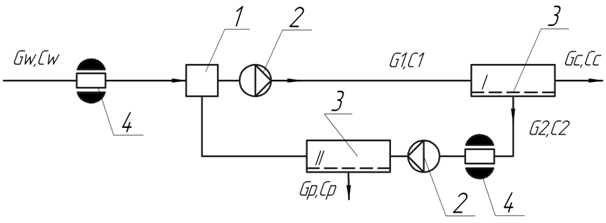
Fig. 2 – Circuit of the plant with an additional module in recirculation line
Plants which connection circuits are given in Fig. 1 and Fig. 2 give a filtrate with necessary salt content with minimum power consumption or filtrate and waste solution with the given salt concentration. In the latter case, a ratio between consumption of various flows is made in such a way so to provide high economic and technological indices of RO plants.
In order to attain a high depth of desalination of treated water it is used cascade circuits of connection of modules as three and more stages. Cascade circuits with recirculation of united flows are more efficient. In such circuits the operation efficiency depends not only on efficiency of a separate stage which is determined by membrane material and method of organization of flows in the module but considerably depends on a direction of medium flows between separating stages.
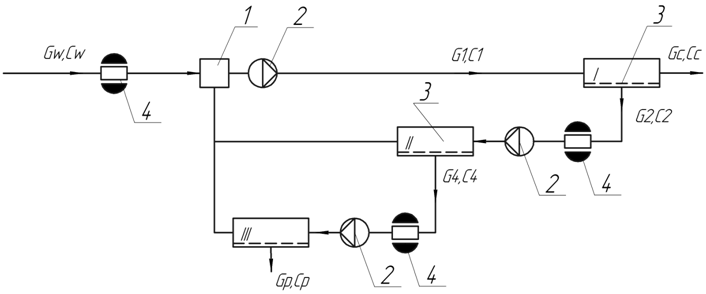
Fig. 3 – Circuit of the double-stage osmotic plant
Water desalination in multistage plants with a high salt concentration in initial water promotes a gradual reduction of salt content as well as decrease of pressures to membranes by stages. If required to provide a certain quality of filtrate and concentrate, in such a case, plants with three groups of apparatuses are preferable. Fig. 3 shows the optimized double-stage circuit of plants with three groups of apparatuses.
According to our evaluation, in order to desalinate waste waters with a high salt content it is appropriate to use a three-stage reverse osmotic plant (Fig. 4).
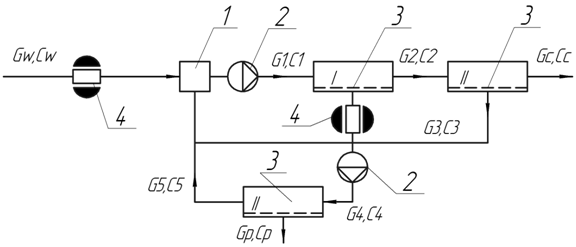
Fig. 4 – Circuit of the three-stage osmotic plant
Using the equation of balances of consumption of water flows and salt concentration in flows we may obtain relationships to calculate a salt content in treated water:
 . (6)
. (6)
Relationships (6) enable to determine y as well as the amount of initial water supplied to the plant (with known ratio  and required consumption of permeate Gp).
and required consumption of permeate Gp).
With the known individual characteristics of a standard module their total requirement may be found  and quantity of modules in the last stage along the concentrate, as well as in all previous
and quantity of modules in the last stage along the concentrate, as well as in all previous  .
.
In order to minimize specific power consumption the circuits of RO plants should apply the ratio  , which characterizes the basic component consumption – power consumption for circulating a medium through RO modules to obtain a permeate volume unit. To optimize the RO plant structure it is required to reduce the quantity of modules in every following stages, provided that the ratio
, which characterizes the basic component consumption – power consumption for circulating a medium through RO modules to obtain a permeate volume unit. To optimize the RO plant structure it is required to reduce the quantity of modules in every following stages, provided that the ratio  , where ni – quantity of modules in i–stage of desalination.
, where ni – quantity of modules in i–stage of desalination.
To optimize the operation mode of multistage RO plants it is proposed to applied magnetic water treatment in the studied circuits.
In so doing, every of the studied circuit modification is equipped with one to three magnetic apparatuses for treatment of medium flows brought to RO modules. Recommended circuits of connecting special magnetic apparatuses are illustrated in Fig. 1–4.
Far Eastern Federal University (FEFU) water treatment laboratory carries out research to evaluate efficiency of water treatment by magnetic field ahead of RO modules. Fig. 5 demonstrates a photo of test bench including a RO plant, type ROU-320, mechanical and ion-exchange filters and water magnetic treatment apparatus, type ЕМА -100 with generated field strength up to 104 amp/m.
The obtained results confirm [7, 8] that magnetic treatment of water favorably influences upon indices of basic water treatment processes, provides the increase in efficiency of RO plants and decreases power consumption for drive of high-pressure pumps.
In long-term studies it is planned to develop a specialized RO module which provides water treatment by magnetic field directly in the process if water filtration through a membrane system.
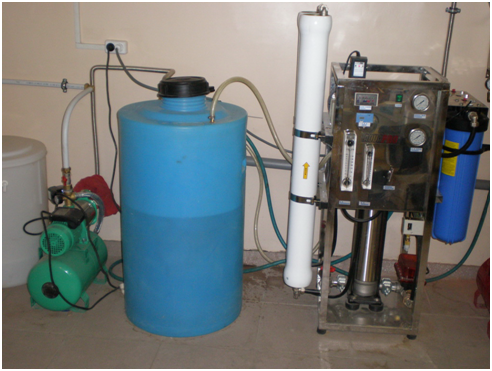 |
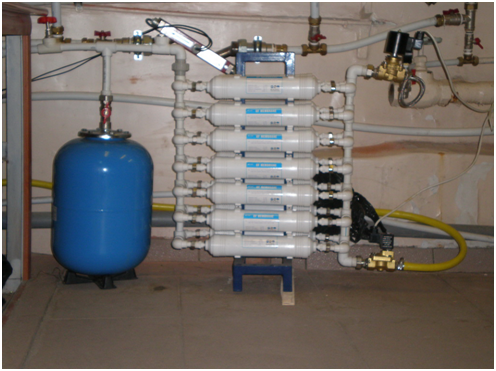 |
Fig. 5 – General view of the test bench in FEFU water treatment laboratory
Conclusions
- The model of the membrane system, which allows to take into account the influence of magnetic water treatment for RO processes are investigated.
- The main technological factors affecting the efficiency of wastewater treatment for RO modules are identified.
- Flow diagrams for the RO modules to allow for magnetic treatment of industrial waste water to be purified from salts of heavy metals are investigated.
- Placement of magnetic devices in circuits wastewater treatment for the correction of the RO modules are recommended.
Acknowledgements
This work was financially supported by the Ministry of Education and Science of the Russian Federation, by order of P 218, the contract № 02.G25.31.0035-225 dated 12 February, 2013 between Open Joint Stock Company "Far East Plant "Zvezda" and the Ministry of Education and Science of the Russian Federation.
Список литературы
Dytnersky Yu. I. Baromembrane processes. – M.: Chemistry, 1986. – 272 p.
Karelin N. F. Water desalination by reverse osmosis. – М.: Stroyizdat, 1988. – 320 p.
Slesarenko V.V. Electrodialysis and reverse osmosis membrane plants at the power stations // Desalination. – 2003. – № 158. – P. 303–311.
Kremnevskaya E.A. Water desalination membrane technology. – М.: Energoatomizdat, 1994. – 160 p.
Schirg, P. Characterization of nanofiltration membranes for the separation of aqueous salt solutions. // Desalination. – 1992. – № 89. – P. 89–107.
Xu X. H., Spencer G. H. Dye-salt separations by nanofiltration using weak acid polyelectrolyte membranes. // Desalination. – 1997. – № 114. – P. 129–137.
Slesarenko V.V., Vasilieva V.V. Peculiarities of application of hydromagnetic apparatuses in water treatment systems // Power saving and water treatment. – 2005. – № 5. – P. 21–25.
Slesarenko V. V., Slesarenko V. N. Simulation of barometric processes in reverse osmosis plants // Transport business in Russia. – 2005. – №3. – P. 144–146.
